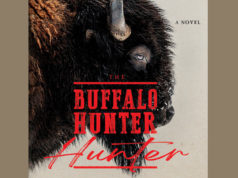If Arthur Penn’s 1967 crime thriller Bonnie and Clyde strikes you as flimsy and overstylized despite its hallowed place in American pop cinema, wait until you read Jeff Guinn’s doggedly researched, compulsively readable Go Down Together: The True, Untold Story of Bonnie and Clyde. To the extent that it’s fair to compare a book and a movie, Penn’s “classic” flick, including its blood-and-bullet-drenched climax, emerges as laughable next to Guinn’s probing analyses of the economic, cultural, and criminal life of North Texas from 1910 to 1934, the dates of Clyde Chestnut “Bud” Barrow and Bonnie Parker’s poverty-stricken births and violent deaths.
Guinn, a Fort Worth resident and former writer for the Star-Telegram, pored over the sa me public and private documents as previous historians. He re-interviewed survivors who knew the principles involved in Parker and Barrow’s multi-state 1932-’34 spree of bank robberies, kidnappings, car thefts, and police killings. But Guinn’s trump card is his unprecedented access to two rare, unpublished sources: aborted memoirs by Clyde’s mother, Cumie, and his little sister, Marie Scoma, both of whom were fiercely protective of the Barrow name but who were privy to conversations and insights that no other researchers had found. At its best, Go Down Together — the title is taken from a long poem Bonnie wrote while on the lam — echoes Capote’s In Cold Blood. A novelist’s rigorous methods for generating character and suspense are applied to an abundance of on-the-record facts and anecdotal details. The result is not just crime reportage but a wide-angle study of how family, community, and nation are unwittingly implicated in the felonies of their wayward members.
me public and private documents as previous historians. He re-interviewed survivors who knew the principles involved in Parker and Barrow’s multi-state 1932-’34 spree of bank robberies, kidnappings, car thefts, and police killings. But Guinn’s trump card is his unprecedented access to two rare, unpublished sources: aborted memoirs by Clyde’s mother, Cumie, and his little sister, Marie Scoma, both of whom were fiercely protective of the Barrow name but who were privy to conversations and insights that no other researchers had found. At its best, Go Down Together — the title is taken from a long poem Bonnie wrote while on the lam — echoes Capote’s In Cold Blood. A novelist’s rigorous methods for generating character and suspense are applied to an abundance of on-the-record facts and anecdotal details. The result is not just crime reportage but a wide-angle study of how family, community, and nation are unwittingly implicated in the felonies of their wayward members.
Barrow and Parker were both residents of the same fetid West Dallas campground slum known as “The Devil’s Back Porch.” While malaria and yellow fever felled the weaker “Porch” dwellers, everyone could gaze eastward across the Trinity River at tall Dallas buildings that symbolized a material success unavailable to them. Bonnie and Clyde shared an overheated fantasy life and oodles of ambition, sometimes misguided: He admired the slick, anti-heroic exploits of Billy the Kid and Jesse James as depicted in movies and magazines. She wanted to be a Broadway star and published poet and saved her pennies forever just to be able to pay for a professional glamour shot of herself. The cheap picture strips at the Fair Park photo booths weren’t good enough.
Penn’s movie gets mired in the couple’s intense desire for glory. Go Down Together uses that hunger as a starting point to highlight the tragicomic personal weaknesses and the social conditions that led the pair to choose brief, fatal celebrity over a life of literally backbreaking labor and privation. Along the way, Guinn clears up a few misconceptions generated by the movie and by the feverishly distorted national press coverage the couple received during the last two years of their lives. (In the first few years of the Great Depression, their exaggerated or just plain phony exploits were a boon to newspaper readership and ad revenue.) Clyde was not a “near-mystical” judge of character who could smell a stool pigeon miles away. He happily welcomed young hood Henry Methvin into the Barrow Gang, unaware that Methvin and his family were communicating with state and federal authorities so that Bonnie and Clyde could be ambushed on a tree-obscured section of Highway 154 near Gibsland, La.
Similarly, Parker was not the amoral, cigar-smoking vixen who orchestrated the Barrow Gang’s worst crimes. (Then-Texas Gov. Miriam “Ma” Ferguson believed this version enough to personally put a bounty on Parker’s head.) Parker was a plain, frail girl who became an alcoholic while soothing the pain of her right leg, crippled after so-called “master escape artist” Clyde drove their Ford V8 off the road while fleeing from authorities. They spent most of their final weeks running, hiding, eating, and sleeping in a series of stolen Fords, Clyde’s favorite. Although the duo died in one such car under a barrage of gunfire led by ex-Texas Ranger Frank Hamer, their suffering was not equal. Without spoiling anything, let’s just say that author Guinn describes some stark forensic discoveries from the autopsies that are more shocking than Faye Dunaway and Warren Beatty’s final onscreen moments.
Go Down Together is unsparing in the details that give the Bonnie and Clyde story a sad inevitability. After a relatively minor early crime, Clyde had been sent to Eastham Prison Farm at Huntsville, a hellhole where he was repeatedly raped by gargantuan inmate Ed Crowder, until the short, skinny victim amassed enough rage to smash his attacker’s skull with a lead pipe. The thread of a hope that Clyde might redeem himself seems pretty much lost after this. Likewise, any chance that Bonnie could turn herself in and receive a short prison sentence ended early on when she was misidentified by a far-off witness as the shooter of two highway patrolmen in Grapevine.
For all of his sober reporting, you sometimes get the sense that Guinn wants to romanticize the careers of Bonnie and Clyde, too, or at least minimize the consequences of their choices. Maybe that’s unavoidable for anyone who studies their strange saga so closely. Since circumstances usually conspired against these hard-luck lovers, their decision to Go Down Together might have been the best option after all.
Arts Notes
I wish I could find something wonderful to say about the debut performance by the new modern company Texas Dance Theatre. Any company launching itself in this economy deserves some kind of medal for bravery. But the 10 dancers on view lacked the punch and personality of seasoned performers, and the choreography by artistic director Wil McKnight and two of his colleagues, Hollis Hock and Emily Hunter, shared much of the same vocabulary, stretching it pretty thin. So what else can you say?
Upstage projections of acrylic-on-glass artwork by Daniel Corona added a splash of color to McKnight’s new piece Fast, set to the music of Steve Reich, but the dancers tended to disappear in front of the oversized images. The evening had the flavor of an earnest, well-rehearsed dance recital: a little too much concentration on getting the steps right and not enough on generating excitement. – Leonard Eureka











